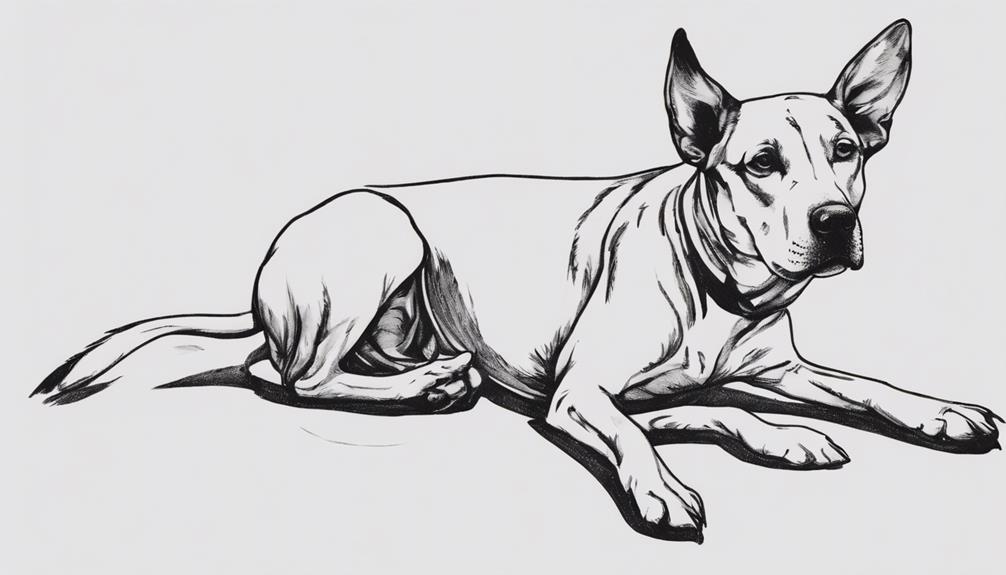13 Tips to Comprehend Canine Communication Signals
Do you think you know everything your furry friend is trying to tell you? Understanding your canine companion's communication signals is crucial for a harmonious relationship, but it goes beyond basic tail wagging and barking.
By mastering these 13 tips, you'll be able to navigate the intricate world of dog language with ease and ensure a deeper bond with your four-legged pal. From subtle ear movements to nuanced body postures, each signal paints a unique picture of your dog's thoughts and emotions.
Decoding Tail Wagging
When deciphering a dog's tail wagging, pay close attention to the speed and direction of the wag. These subtle movements can convey a variety of messages through tail language nuances.
For instance, a fast wagging tail held high often signifies excitement or happiness, while a slow wag with a lowered tail may indicate insecurity or submission. Wagging variations are key to understanding your furry friend's emotions.
A broad, sweeping wag typically indicates a friendly and welcoming attitude, whereas a stiff, rapid wag could signal agitation or potential aggression. The direction in which the tail is wagging also plays a crucial role in decoding your dog's communication.
A wag to the right is often associated with positive feelings, while a wag to the left might indicate negative emotions. By observing these tail wagging cues and variations, you can better comprehend what your canine companion is trying to express.
Interpreting Ear Position
Deciphering your dog's ear position can provide valuable insights into their current state of mind and emotions. Dogs use ear language to communicate a wide range of feelings, so paying attention to the position of their ears is crucial for understanding your furry friend better.
When your dog's ears are perked up and facing forward, it usually indicates alertness and curiosity. On the other hand, ears flattened against the head suggest fear, anxiety, or submission. If your dog's ears are relaxed and in a neutral position, it often means they're feeling content and at ease.
Observing your dog's ear position in different situations can help you gauge their emotional state and respond accordingly. For example, if your dog's ears are pinned back while interacting with another dog, it might signal discomfort or aggression. By being mindful of these subtle cues in their ear language, you can strengthen your bond with your canine companion and ensure a harmonious relationship based on understanding their canine emotions.
Understanding Eye Contact
Observing your dog's eye contact can offer valuable insights into their emotional state and intentions. Dogs use eye contact to communicate various messages. For instance, blinking communication is a sign of relaxation and can indicate that your dog feels comfortable and at ease. On the other hand, pupil dilation can signal excitement or stress, suggesting a heightened emotional state.
Staring can have different meanings depending on the context. If your dog maintains prolonged eye contact with you, it may be a sign of dominance or a challenge for leadership. In contrast, averted eyes can indicate submission or fear. Understanding these nuances in eye contact can help you better interpret your dog's feelings and respond appropriately.
Next time you interact with your furry friend, pay attention to their eye contact cues. By recognizing the subtle signals they convey through their eyes, you can deepen your bond and ensure positive interactions based on understanding and communication.
Deciphering Vocalizations
Pay close attention to the various sounds your dog makes to better understand their feelings and needs. Understanding bark patterns can provide valuable insights into what your furry friend is trying to convey. For example, a rapid, high-pitched bark may indicate excitement or eagerness, while a slow, deep bark could signal a warning or potential threat. It's essential to consider the context in which the barking occurs to accurately interpret its meaning.
Interpreting growling tones is another crucial aspect of deciphering your dog's vocalizations. Growling can signify various emotions, such as fear, aggression, or playfulness. A low, guttural growl accompanied by bared teeth is often a sign of aggression and should be taken seriously. On the other hand, a softer, playful growl during a game is typically harmless and part of the fun.
Analyzing Body Language
Understanding your dog's body language is key to interpreting their feelings and intentions accurately. Analyzing posture and interpreting facial expressions are essential aspects of understanding what your canine companion is trying to communicate.
Paying attention to your dog's posture can provide valuable insights into their mood. A relaxed and loose posture often indicates that your dog is feeling comfortable and at ease, while a tense posture with raised fur may signal agitation or fear.
Additionally, observing your dog's facial expressions can help you gauge their emotional state. For example, a soft gaze and relaxed mouth typically indicate a calm and content demeanor, whereas a wrinkled forehead or bared teeth may suggest discomfort or aggression.
Recognizing Stress Signals
To further deepen your comprehension of canine communication, it's crucial to be able to recognize stress signals exhibited by your dog. Identifying anxiety in your furry friend is essential for their well-being. Some common stress signals include panting excessively, yawning when not tired, or avoiding eye contact. Dogs may also exhibit pacing, whining, or trembling when feeling anxious.
Spotting fearfulness is equally important. If your dog tucks their tail between their legs, cowers, or tries to hide, they may be experiencing fear. Ears pinned back, dilated pupils, or raised fur are additional signs of stress. Understanding these signals can help you alleviate your dog's discomfort and create a safe environment for them.
Paying attention to your dog's body language and behavior will allow you to respond appropriately and ensure a positive relationship built on trust and understanding. By recognizing stress signals early on, you can address any underlying issues and provide comfort to your canine companion.
Noting Submissive Behaviors

Recognizing submissive behaviors in your dog can provide valuable insights into their emotions and interactions with others. Understanding submission cues is crucial in interpreting your dog's state of mind. Submissive postures often include lowering the body, tucking the tail between the legs, averting eye contact, and even rolling over to expose the belly. These behaviors signal a desire to avoid conflict and show deference to others, whether it be other dogs or humans.
When you observe your dog displaying these submissive cues, it's essential to respond with reassurance and calmness. Avoid reinforcing submissive behaviors through punishment, as this can lead to increased anxiety and confusion in your dog. Instead, offer gentle praise and encouragement to help build their confidence and sense of security.
Grasping Aggressive Cues
When observing your dog, pay close attention to signs of aggression to ensure a safe and healthy environment for all. Recognizing warning signs and handling confrontational behaviors are crucial for maintaining a positive relationship with your furry friend. Here are some tips to help you grasp aggressive cues effectively:
- Body Language: Watch out for stiff posture, raised fur, bared teeth, and a fixed gaze. These are common indicators that your dog is feeling threatened or aggressive.
- Growling or Snarling: If your dog starts growling or snarling, it's a clear sign of aggression. Take a step back and assess the situation calmly.
- Protective Behavior: Dogs can become aggressive when they feel the need to protect their territory, toys, or food. Respect their boundaries and avoid triggering confrontational situations.
- Seek Professional Help: If your dog displays consistent aggressive behavior, seek guidance from a professional trainer or behaviorist to address the underlying causes and implement appropriate training techniques.
Frequently Asked Questions
How Can I Tell if My Dog Is Feeling Anxious or Nervous?
To recognize signs of anxiety or nervousness in your dog, pay attention to body language like trembling, yawning, or avoiding eye contact. Understanding behavior cues such as pacing, excessive panting, or whining can also indicate stress.
Stay attuned to your pup's signals and provide a calm environment to help them feel safe. Remember, your furry friend may communicate distress in subtle ways, so observe closely and offer reassurance when needed.
What Are Some Common Ways Dogs Show Affection Towards Their Owners?
Dogs often show affection by giving you puppy kisses, wagging their tail happily when they see you. They may also cuddle up close or lean against you for comfort and security.
These actions are their way of expressing love and forming a strong bond with you. By paying attention to these gestures, you can better understand and appreciate the deep connection your furry friend shares with you.
Why Do Some Dogs Growl or Bark When They Are Playing?
When dogs growl or bark during play, it's often a sign of excitement and engagement. Playful growling and interactive barking are common ways for dogs to express their enjoyment and communicate with you. Understanding canine playfulness involves recognizing these behaviors as part of their playful nature.
Can a Dog's Body Language Change Depending on the Situation or Environment?
Yes, a dog's body language can change depending on the situation or environment. Canine adaptation to environmental cues is common, leading to behavioral changes. Situational cues play a significant role in how dogs express themselves physically.
Paying attention to these shifts can help you better understand your furry friend's feelings and needs. Observing their body language in various settings will give you insight into how they're responding to their surroundings.
Are There Any Specific Ways to Help a Dog Feel More Comfortable and Secure in New Situations or With New People?
When helping a dog feel secure in new situations or with new people, socialization techniques and desensitization methods can be beneficial.
By gradually exposing your dog to different environments, people, and stimuli in a positive and controlled manner, you can help them build confidence and reduce anxiety.
This process can help your furry friend feel more comfortable and secure, leading to better overall well-being and behavior in various situations.
Conclusion
By learning to understand your dog's communication signals, you can strengthen your bond and improve your relationship. Pay attention to their tail wagging, ear position, eye contact, vocalizations, body language, stress signals, submissive behaviors, and aggressive cues.
By recognizing these cues, you can better respond to your dog's needs and create a happier and healthier environment for both of you.
So, take the time to observe and comprehend your canine companion's language – it will make a world of difference.
